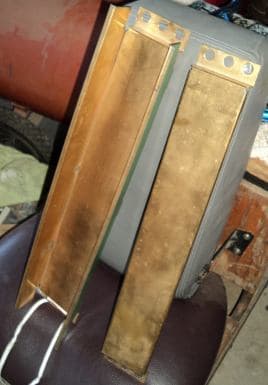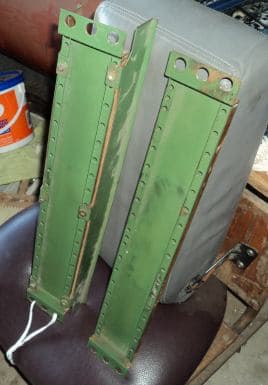
Curated with aloha by
Ted Mooney, P.E. RET

The authoritative public forum
for Metal Finishing 1989-2025

-----
Aluminum Reflectors: UV reflectance data, bright dipping info, misc. Q&A
Q. Hi. I work for a coil anodizer, specializing in clear sheet for the lighting market. Recently, one of our customers had a question about UV reflectance of our products. I've found a couple of labs that can do the work for me, but I have not been able to find any reference books, etc., on the reflective properties of anodized aluminum. Any clues where I might find this information?
Thanks.
Gerald Janssen, Staff Chemistaluminum coil anodizing - Streamwood, Illinois
1998
A. Hi, Gerald.
ASM Metals Handbook, vol. 5, Surface Engineering .
has a good chapter on reflective aluminum finishes including some reflectance data for brite dipped and electropolished aluminum. For me, the takeaways from that interesting chapter were:
- Which alloy matters a lot. Ultrapure aluminum gives good reflectance, most alloys significantly less.
- Anodizing has to be very thin. It's not really transparent as we'd wish; it's partially transparent.
- Electropolishing is superior to bright dipping for high reflectivity. With very pure aluminum and very thin anodizing, the difference is a lot. But with some alloys and thicker anodizing the difference may not amount to much.
Perhaps a supplier of proprietary bright dip solutions like Phosbrite by Albright & Wilson can help you. Presumably, they would have done tests to determine that their chemistry brightens as good as or better than generic solutions. Good luck.

Ted Mooney, P.E.
Striving to live Aloha
finishing.com - Pine Beach, New Jersey
1997
1999
RFQ: Hi Gerald,
Although I do not have the specific information you are looking for with respect to measuring UV reflectance, I am in the business of manufacturing specular reflectors for the fluorescent lighting industry, and I am presently looking for a new source of anodized aluminum lighting sheet. If your company produces specular anodized aluminum sheet with specular reflectances between 87% to 95% I would be very interested in receiving some information from your company. Or, if you know of a supplier that does have this type of sheet I would be pleased if you could provide me with a contact. Thank you very much.
Regards,
Bill G Toronto, Ontario, Canada [last name deleted for privacy by Editor]Ed. note: This RFQ is outdated, but technical replies are welcome, and readers are encouraged to post their own RFQs. But no public commercial suggestions please ( huh? why?).
Aluminum reflectors for infrared application
Q. I presently use mill finish aluminum reflectors, but would like a more efficient and non-deteriorating material.
Anodized aluminum typically, while excellent for visible light, is not a good reflector for 7-8 micron wavelengths infrared energy.
Any suggestions?
Manufacturer - Terence Bay, N.S., Canada
July 28, 2011
A. Hi, Al
I know that some manufacturers of infrared reflectors for infrared drying systems use the same general technology mentioned above, of brite dipping and anodizing, but they add a gold dye step. I don't have data about how well it actually works, if at all -- but they should.
NASA uses gold electroplating (or sometimes gold sputtering) on satellite-mounted infrared telescopes. While this is fine for telescopes, the cost of gold probably makes this impractical for more mundane products. Good luck.
Regards,

Ted Mooney, P.E.
Striving to live Aloha
finishing.com - Pine Beach, New Jersey
July 29, 2011
Gold plated reflectors
Q. My name is kurt linderman and I'm in possession of some infrared lamp reflectors used in industry that have gold plating covering a green powder coating. Their measurements are approximately 20" by 4" and there are six panels. Without the depth of the coating how would you figure out the volume of gold. What is the typical depth of coating for full coverage for a reflective surface? I attach some photos. Thanks.


P.S.: I'm trying to come up with a quote for additional panels; need info.
kurt lindermanmaintenance electrician - chula vista, California USA
September 18, 2014
A. Hi Kurt. What is the substrate, steel? Are you sure it's plating over powder coating rather than the reverse? Other than the general color, is there any other reason to believe this is actually gold?
You would probably have good color with 1/4 micron (10 millionths of an inch) if the gold is plated on a bright nickel layer. If it's plated on bare cold finished steel, I'm not familiar with that but would take a wild guess that 1/4 micron might not be enough, but closer to 1/2 micron would. You would get little corrosion resistance (rust prevention) from very thin coatings, but for indoor use you may not need it.
Regards,

Ted Mooney, P.E.
Striving to live Aloha
finishing.com - Pine Beach, New Jersey
September 2014
Q. It is most definitely gold plating. As you are probably well aware, the emmisivity coefficient of polished gold at 300 K is .025, which is why all the satellites have all the gold foil all over them. This allows the surface to reflect and or radiate nearly all solar radiation thus keeping the temperature to a minimum. In space, or in a vacuum this is a critical issue since there is no convective cooling. Anyway, what you're saying is 1/2 micron is that .000005 or .0000005. Five microns is five times ten to the minus 6 so .5 microns would be 5 times ten to the minus seven is that correct?
kurt linderman- chula vista California U.S.A.
September 21, 2014
A. Hi again. Yes, good quality costume jewelry is sometimes called "micron gold": 1 micron thickness, and good color can be seen at 1/4 of that thickness on polished jewelry. So I'm guessing that 1/2 micron (5 x 10 -7)^meterswould give you good color on a rougher substrate. That's a starting point, not an answer, and you should be able to check the thickness on the existing units.
Regards,

Ted Mooney, P.E.
Striving to live Aloha
finishing.com - Pine Beach, New Jersey
September 2014
Ted
I think the unit of measure is being lost. 1 micron is .00004"
- Colorado Springs, Colorado
September 26, 2014
![]() Thanks Willie. You're right that I had left out the units of measure. Fixed now. 1/2 micron is .0000005 meters or approx., as per your conversion factor, .00002"
Thanks Willie. You're right that I had left out the units of measure. Fixed now. 1/2 micron is .0000005 meters or approx., as per your conversion factor, .00002"
Regards,

Ted Mooney, P.E.
Striving to live Aloha
finishing.com - Pine Beach, New Jersey
September 2014
A. I'm not an expert on infrared reflectivity, but according to Wikipedia the reflectance of titanium nitride is very similar to that of gold, and a lot cheaper to apply. Might also look at zirconium-based coatings as well. They've pretty much eliminated gold plating in the faucet hardware business.

Jim Treglio - scwineryreview.com
PVD Consultant & Wine Lover
San Diego, California
September 26, 2014
Q, A, or Comment on THIS thread -or- Start a NEW Thread
